Accidental Inventions
12 INVENTIONS DISCOVERED BY ACCIDENT
 These inventors were trying to solve specific problems but their work accidentally created unexpected inventions.
These inventors were trying to solve specific problems but their work accidentally created unexpected inventions.
In 1942, chemist Harry Coover Jr. and a team of scientists working for Kodak Research Laboratories were trying to improve gunsight lenses by using optical plastic instead of glass.
During their research they invented by accident acrylic resins known as "cyanoacryclates".
These acrylic resins were fast bonding adhesives but of little value in developing optical plastic lenses and consequently put aside.
In 1952, Coover and his team were researching heat resistant acrylate polymers for use on jet canopies. Fred Joyner was studying the composition and density of cyanoacrylates with a refractometer (an instrument that measures the movement of light through a medium).
He sandwiched a thin film of ethyl cyanoacrylate between two prisms in the refractometer. After taking his measurements, Joyner couldn't remove the prisms because they were fused together thus destroying an expensive instrument.
Coover realized that the adhesive properties of ethy cyanoacrylate had commercial potential. In 1958, Kodak began marketing ethy cyanoacrylate as Eastman Compound #910 - a fast-bonding, non-toxic, colorless, super strong glue.
Compound #901 was later sold under the trade names Super Glue and Krazy Glue.
Derivations of Krazy Glue were marketed as skin adhesives, veterinary glues and for use in surgery as medical bonding agents.
Coover is credited with 460 patents and has received numerous awards for his innovations.
He was inducted into the National Inventor's Hall of Fame and was awarded the National Medal of Technology and Innovation. Coover died at age 94 at his home in Tennessee on March 26, 2011.
Source: krazyglue.com
Twinkies
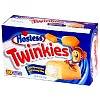 James Dewar was a baker working at the Continental Baking Company in Schiller Park, Illinois on the outskirts of Chicago in 1930.
James Dewar was a baker working at the Continental Baking Company in Schiller Park, Illinois on the outskirts of Chicago in 1930.
Dewar made strawberry cream filled shortcakes but whenever strawberries were out of season and not available, his cream filling equipment sat idle.
So to resolve this inefficient use of his equipment, Dewar started making banana cream filled sponge cakes. He called his cakes "Twinkies" - a name he concocted after being inspired by a billboard advertising "Twinkle Toe" shoes.
Twinkies weren't as popular as strawberry shortcakes. When bananas and other ingredients were rationed during World War II the company had to create a new sponge cake.
A new recipe was created using a vanilla cream filling similar to cake frosting. Ladyfinger shaped sponge cakes were baked and injected with the vanilla cream through three holes in the top, flipped over, and packaged in cellophane.
The tasty Twinkie became a sensation and was renowned for it's amazing freshness. In fact, freshness probably explains the reason for it's popularity.
Although rumored to have a shelf life of 50 years and stay edible for decades, this isn't true. A Twinkie's best before date is 25 days but that's still unusual for a bakery product.
 The
secret behind the freshness is the
absence of any dairy derived
ingredients.
The
secret behind the freshness is the
absence of any dairy derived
ingredients.
Food rationing not only eliminated bananas but also milk, cream and butter. So due to wartime circumstances, Dewar accidentally invented a bakery snack that wouldn't stale easily.
In 2012, Hostess Brands, the maker of Twinkies, closed it's operations due to insolvency thus leaving the future of the popular sponge cake in doubt.
Source: hostess.com
Popsicle
Eleven-year old Frank Epperson sat on his porch stirring fruit flavored soda powder into a glass of water - a popular drink at the time.
He went inside the house but forgot about his drink on the porch, with the stirring stick left standing in the glass.
It was a very cold winter night in San Francisco. The temperature fell below freezing. In the morning, young Epperson found his beverage frozen.
He slowly pulled the stir stick from the glass with the frozen drink attached creating one of the world's best known accidental inventions - the popsicle.
It was 1905, and Epperson kept his secret to himself until he was 28 years old.
In 1922, he revealed his frozen pop at a fireman's ball and began selling them at an amusement park in Alameda, California. He initially called his frozen pop an "Eppsicle" but later changed it to "Popsicle".
In 1924, he patented "a handled, frozen confection or ice lollipop" and founded the Popsicle Corporation. In 1925, he sold his patent and company to Joe Lowe Corporation.
 Popsicles were promoted as "frozen drinks on sticks" and came in
seven flavors. The twin popsicle was introduced
that joined two parts together with two sticks
allowing the treat to be shared with another.
Popsicles were promoted as "frozen drinks on sticks" and came in
seven flavors. The twin popsicle was introduced
that joined two parts together with two sticks
allowing the treat to be shared with another.
By 1928, Epperson had received royalty payments on the sale of more the 60 millions popsicles.
Today, the popsicle brand is owned by Unilever, who sell over 2 billion popsicles each year in thirty different flavors. The most popular flavor has always been, and still is, the original classic orange.
Source: popsicle.com
Potato Chip
 In 1853, George Crum was a cook for the Carey Moon
Lake House restaurant in Saratoga Springs,
New York. The restaurant was well known for
its delicious thick-sliced fried potatoes.
In 1853, George Crum was a cook for the Carey Moon
Lake House restaurant in Saratoga Springs,
New York. The restaurant was well known for
its delicious thick-sliced fried potatoes.
As local legend has it, a customer sent his plate of fries back to the kitchen complaining that they were too thick and requesting thinner slices.
Crum obliged the customer's request but the customer was still unhappy and again sent his fries back to the kitchen requesting thinner slices.
Indignent, Crum cut paper-thin slices of potatoes and deep fried them in fat used for cooking doughnuts. He retrieved the crunchy, crispy slices from the fryer, saturated them in salt, and served them to his customer - who loved them!
Word quickly spread about the potato chips and customers came from far and wide to get them, including the rich and famous like the Vanderbilts and Hiltons.
Crum soon opened his own restaurant and served his infamous "Saratoga Chips" in baskets and take-out boxes.
The rest of the story is... as they say... history. Today, this accidental invention is the most popular snack food in America.
Source: saratoga.com
Cornflakes
 In 1896, Dr. John Harvey Kellogg was the superintendent
of the Battle Creek Sanitarium, a world renowned wellness
centre and hospital in Michigan.
In 1896, Dr. John Harvey Kellogg was the superintendent
of the Battle Creek Sanitarium, a world renowned wellness
centre and hospital in Michigan.
The facility first opened in 1866 adopting the diet regime favored by the the Seventh-day Adventists. The center encouraged its patrons to follow a diet low in fat and protein but rich in whole grains, fiber and nuts.
Dr. Kellogg also encouraged the elimination of caffeine, meat, alcohol and tobacco consumption and emphasized fresh air, exercise and proper hygiene for a healthy lifestyle.
Battle Creek was a popular destination for the rich and famous including the first lady Mary Ann (née Todd) Lincoln.
Kellogg together with his brother Will, experimented with whole grains to create various foods including a coffee substitute. But their most famous invention was corn flakes.
While making bread dough one day, Will had mistakenly left some boiled wheat on a counter for several hours. When he attempted to roll the dough it was so dry that it broke into flakes. John Kellogg baked the flakes and served them to his patients who raved about them.
The brothers experimented with their accidental invention and eventually selected corn instead of wheat to make their flakes.
In 1906, the Battle Creek Toasted Corn Flakes Company was founded, which later became the Kellogg's company.
Source:kelloggs.com
Post-It Notes
 In 1968, Spencer Silver, a chemist
working for 3M, was trying to make
a super glue but instead he accidentally invented a
reusable adhesive.
In 1968, Spencer Silver, a chemist
working for 3M, was trying to make
a super glue but instead he accidentally invented a
reusable adhesive.
The glue was unique because it was strong enough to stick pieces of paper together yet weak enough to pull them apart without tearing.
The only problem was that no one knew what to do with it. It didn't have any practical use.
Silver thought of making an adhesive spray that consumers could spray on surfaces to make them into sticky boards but his colleagues were less than enthused.
For the next five years, Silver tried to find a use for his glue without much success.
Then one day, a 3M product developer named Arthur Fry had an idea while singing at Church. He was using pieces of paper to bookmark pages in his hymnbook but the pieces kept falling out.
Fry thought that if he could coat paper with Silver's adhesive then he would have a re-adherable stationery that could be attached to documents or other surfaces.
Market research was conducted in selective cities with free samples being issued to consumers. Machinery was designed and built to manufacture the product.
Five more years passed before Post-It Notes officially appeared in stores.
Today, Post-it Notes are available in more than 100 countries and has been one of 3M's most profitable products.
Source:post-it.com
Vaseline
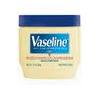 Robert Chesebrough was a twenty-two year old
chemist from Brooklyn who
made his living distilling fuel from sperm
whale oil. But his business was declining
because of the booming petroleum industry.
Robert Chesebrough was a twenty-two year old
chemist from Brooklyn who
made his living distilling fuel from sperm
whale oil. But his business was declining
because of the booming petroleum industry.
So in 1859, the entrepreneurial Chesebrough headed to the oil fields of Pennsylvania looking for potential opportunities.
Chesebrough was hoping to develop a fuel product. Instead, he invented one of world's most popular accidental inventions.
He heard about a black goo-like wax that adhered to oil rigs causing them to malfunction, but was surprised to learn that drillers used the substance they called "rod wax" to heal cuts and burns.
Chesebrough took samples back to his lab in Brooklyn for analysis. He vacuum distilled the goo and filtered it into a light-colored gel.
He experimented using it on cuts and burns before enthusiastically promoting his petroleum jelly, which he named "Vaseline", to drug stores throughout New York.
Chesebrough did demonstrations and gave away free samples of his healing ointment. He founded the Chesebrough Manufacturing Company and patented his process, (U.S. Patent 127,568).
Although petroleum jelly has no medicinal ingredients and can't be absorbed by the skin, it's healing qualities result from forming a barrier that prevents moisture from evaporating and bacteria from entering the skin.
During the 1880's Vaseline sold at the rate of one jar every sixty seconds.
Source: vaseline.com
Gunpowder
 China has over 100,000 medicinal recipes recorded in their
ancient literature.
China has over 100,000 medicinal recipes recorded in their
ancient literature.
One of these recipes was used to aid indigestion and contained the ingredients of sulfur, charcoal and saltpeter (potassium nitrate), the same ingredients used to make gunpowder.
The medicinal remedy would often explode when heated, which lead to the accidental invention of gunpowder.
For this reason the recipe was called "fire medicine", but the explosive qualities of the black powder found a better use as a propellant, and was used to develop weapons and explosives.
The propellant was called 'huo yao' meaning fire chemical, which we know today as gunpowder.
Silly Putty
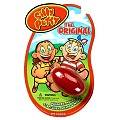 During World War II the United States contracted
companies to create a synthetic rubber. One of
those companies was General Electric.
During World War II the United States contracted
companies to create a synthetic rubber. One of
those companies was General Electric.
Rubber was critical for the manufacturing of engine parts, boots, raincoats, gas masks, life rafts and much more.
Japan had interrupted America's rubber supply from Asia, which caused a shortage of rubber and consequently rationing.
James Wright, a chemist for General Electric was assigned to the rubber project. In 1943, while experimenting at his laboratory in Connecticut, he created a putty-like material when he mixed boric acid with silicone oil.
The substance had strange properties. It could be stretched, modeled or bounced. You could press it on clothing to pick-up dust, lint or animal hair, or roll it over newsprint and pick-up images that could be stretched and distorted.
But it wasn't a replacement for rubber. Curious to find some need or demand for his accidental invention, Wright sent samples to other scientists. However, that proved uneventful and Wright resigned himself to amusing guests at parties with the strange "nutty putty".
In 1949, one of those guests was toy store owner Ruth Fallgatter. She thought of selling the putty as a toy novelty.
Fallgatter hired marketing consultant, Peter Hodgson, who advised packaging the putty in plastic containers and selling them through Fallgatter's retail catalog. Sales were good but less than crayons, and Fattgatter decided not to pursue the product.
However, Hodgson still believed that the putty had commercial potential. He licensed the product from General Electric, packaged it in plastic eggs, named it "Silly Putty", and headed to the New York Toy Fair with samples.
Reaction to "Silly Putty" was indifferent until a story appeared in The New Yorker magazine. A writer for the magazine had bought some Silly Putty that Hodgson had on display at a Doubleday bookstore.
The journalist played with it, was amazed by it, and wrote a great story about it, which caused an avalanche of orders that made Hodgson rich.
Upon his passing in 1976, Hodgson's estate was valued at $140 million.
Source: crayola.com
Slinky
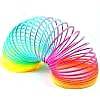
Richard James was a mechanical engineer working at the William Cramp and Sons shipyards in Philadelphia.
In 1943, James was building meters to monitor the horsepower of ship engines. The meters needed supporting tension springs to stabilize them aboard a ship.
While designing these springs, he accidentally knocked one off a shelf but it didn't fall as he expected. Instead, the coil flipped end over end as if it was walking. It stepped from stack of books - onto a table - to a chair - then came to rest on the floor.
James immediately realized that his accidental invention could be a popular toy. He started experimenting with different steel wire designs to see which ones worked best. Within a year he had perfected a working prototype. The spring stood 2 1⁄2" tall, and consisted of ninety-eight coils of top-grade blue-black Swedish steel.
He decided to market the product himself and started the James Spring & Wire Company (later James Industries) and arranged for a local machine shop to manufacture the springs.
He named his toy "Slinky" and approached toy stores to distribute his innovation. However, he was advised by retailers that "Slinky" wouldn't sell sitting on a shelf. It would have to be demonstrated.
So James fabricated a display that showed how the "Slinky" walked down a series of steps. Gimbels Department Store then arranged for James to demonstrate his toy at their Philadelphia location on November 25, 1945.
James charged customers $1 for each unit, and within 90 minutes he had sold his entire stock of 400 units.
Slinky became a national phenomenon selling 100 million units in less than 2 years. To put that in prospective, adjusted for inflation, it would be the equivalent of grossing a billion dollars over the same period of time today.
Inventor, Helen (Herrick) Malsed, designed and patented pull-toys using Slinky spring coils, which she licensed to James Industries.
Beginning in 1952, James marketed the "Slinky Dog" and "Slinky Train" and paid Malsed approximately $1.2 million in royalties for her idea.
Source: poof-slinky.com; image: anolasco
Microwave Oven
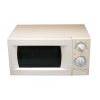
Percy Spencer was an engineer working for Raytheon Company, an American military contractor.
Spencer was conducting experiments using microwave radar transmitters.
He would send high powered beams of microwaves (electrical and magnetic energy) from an antenna. A receiver would then detect the waves reflecting off metal targets, which would pinpoint their location on a radar screen.
Spencer accidentally discovered that microwaves heated food when a chocolate bar in his pocket melted during one of his experiments.
He constructed a metal box with a radar transmitter attached to it so he could send microwaves into the box. When food inside the box was exposed to microwaves it heated rapidly.
Microwaves pass through non-metal materials such as glass, ceramic, paper and plastic but reflect off metal materials, which makes them useful for radar. However, food absorbs microwaves, which causes water molecules to vibrate. This vibration causes friction - which creates heat - that cooks the food.
Spencer realized that foods with a lot of water content, like fresh vegetables, cook more quickly because they produce more heat.
In 1945, the Raytheon Company filed a patent for the "microwave oven".
In 1947, the first microwave oven to appear in public was at Grand Central Station in New York City. A microwave vending machine called the "Speedy Weeny" dispensed sizzling hot dogs.
Initially, microwave ovens were large and expensive, and only a small percentage of American households could afford them. By 1975 just 14% of Americans owned a microwave. But the microwave oven would eventually become one of those accidental inventions that everyone would use.
Today, because of advances in technology and lower costs, over 90% of American households now use microwave ovens.
Sources: raytheon.com; fda.gov image: hisks
Dynamite
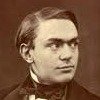 Alfred Nobel was the son of Immanuel Nobel, an
inventor, engineer,
and manufacturer of explosives.
Alfred Nobel was the son of Immanuel Nobel, an
inventor, engineer,
and manufacturer of explosives.
In the late 1800's, explosives were manufactured using gunpowder or nitroglycerine.
Nitroglycerine was more powerful than gunpowder, and was used with a detonator for demolition, mining, construction blasting and munitions.
But the oily, colorless nitroglycerine (a mixture of glycerol and nitric acid) was unstable and volatile. Accidental explosions were common - easily triggered by sudden changes in motion, friction and temperature.
On 3 September 1864, Nobel's younger brother Emil was killed in a nitroglycerine explosion at their factory in Stockholm.
On October 10, 1865, Alfred constructed buildings on forty-two hectares of land he purchased near Krümmel, Germany. It was an isolated area along the Elbe river where he planned to manufacture nitroglycerine.
The buildings were separated from one another by large earth embankments. He also built a laboratory on a barge anchored in the middle of the river.
On July 12, 1866, while working in his river laboratory, Alfred dropped and shattered a vial of nitroglycerine on the floor. It should have exploded but it didn't. He noticed that sawdust on the floor had absorbed the liquid.
He discovered that the sawdust was mixed with dirt from the embankments surrounding his factory buildings. These embankments were made of diatomaceous earth, which is the fossil accumulation of silica from dead microscopic single-celled marine algae.
 When diatomaceous earth was mixed with
nitroglycerine it stabilized the explosive.
When diatomaceous earth was mixed with
nitroglycerine it stabilized the explosive.
In 1867, Nobel applied for patents for his accidental invention, which he called "Dynamite".
Alfred founded the Nobel Dynamite Trust Company (Dyno Nobel) and licensed his patents to over 16 manufacturing companies in 14 countries in return for controlling interest in those companies.
He was granted 350 patents and had ninety factories in twenty countries.
Nobel died in 1896 bequeathing the bulk of his wealth to the establishment of the Nobel Prize.
The Nobel Prize, which includes a substantial monetary award, has been awarded annually since 1901 for achievements in physics, chemistry, physiology or medicine, literature and peace.
Sources: dynonobel.com; nobelprize.org




